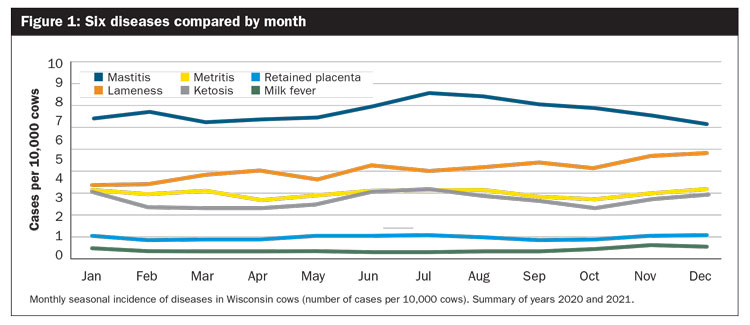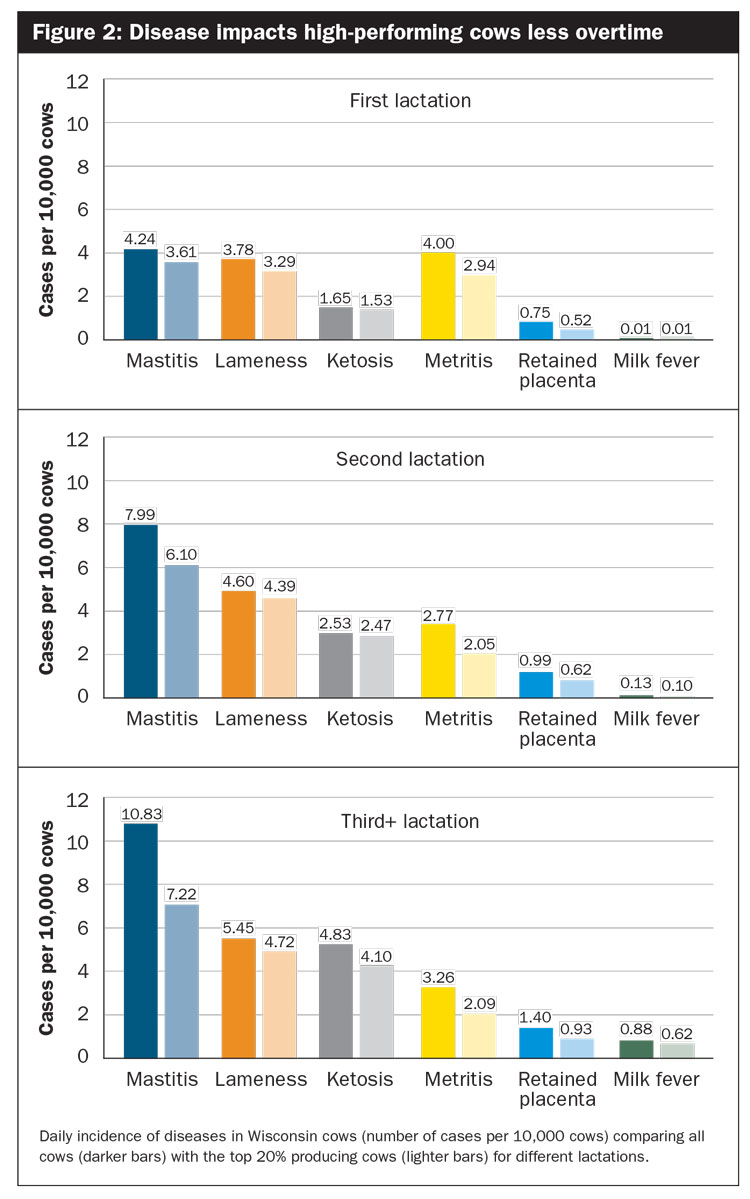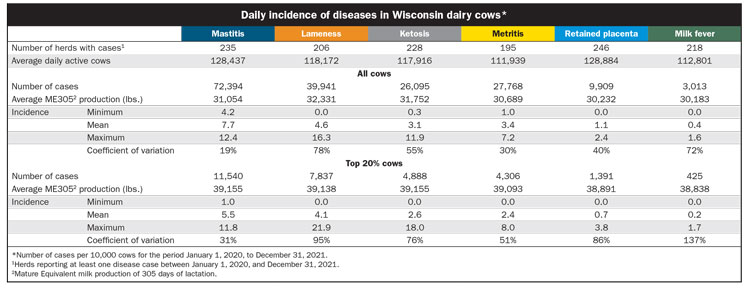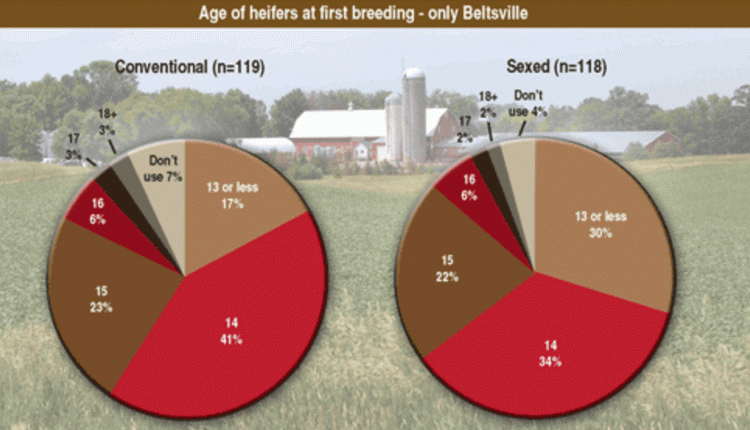Disease can have a significant impact on both dairy cattle welfare and the financial success of the entire dairy industry. This, in turn, impacts sustainability. Not only do diseases lead to reduced productivity and higher treatment costs, but they can also harm the public perception of the industry as a whole.
This is why monitoring and understanding disease incidence in dairy cattle is crucial for improving herd health, productivity, and profitability. Through monitoring and benchmarking disease incidences, dairy farmers and industry professionals can gain valuable insights into the health of their herd compared to the larger population and make informed decisions about management practices that support healthier cows.
A six-pack focus
We studied the incidence of six diseases: mastitis, lameness, ketosis, metritis, retained placenta, and milk fever. We did this by looking at daily historical health reports in the Dairy Herd Information (DHI) test records contained in the AgSource database from a two-year span between January 1, 2020, and December 31, 2021.
The data pertain to Wisconsin herds self-reporting disease cases. The incidence was determined by the number of disease cases reported in the health records divided by all lactating active cows on the same day reported in the production records.
For mastitis, we used the incidence rate only for new infections, excluding those possible cases occurring within 14 days of a previous case. Further, we evaluated the relationship between milk productivity and disease incidence by segregating the top 20% of cows based on 305-day mature equivalent production (305 ME) and comparing their disease incidence with the disease incidence of the overall population.
The data in the table shows that the number of herds reporting individual diseases during the two-year period ranged from 195 (metritis) to 235 (mastitis), accounting for between 112,000 (metritis) and 128,000 (mastitis) daily active cows used in the analysis.
As expected, the largest overall number of a single reported disease during the two-year period was mastitis with more than 72,000 cases. The lowest number of a single disease reported was milk fever with a little over 3,000 cases.
The daily incidence rate for all cows (number of cases per 10,000 active cows) varied between 7.7 for mastitis to 0.4 for milk fever. Therefore, in a typical year, approximately 28% (7.7*365/100) of cows had mastitis, 17% experienced lameness, 11% had ketosis, 12% had metritis, 4% had a retained placenta, and 1% had milk fever. In a typical year, an average cow had a 73% chance of contracting any of the six diseases.
The top performers
The incidence of any disease for the top 20% of cows based on milk production was significantly lower than that for all cows. The yearly accumulated chance of disease for the top 20% cows was 20% for mastitis, 15% for lameness, 10% for ketosis, 9% for metritis, 2% for retained placenta, and 1% for milk fever.
Hence, the percentage of incidence reduction for the top 20% cows in relationship to all cows was the greatest for milk fever and retained placenta (36% less), followed by metritis (30%), mastitis (28%), ketosis (14%), and lameness (12%). These results suggest that high-producing cows tend to have less disease incidence. We speculate this was because management conditions that promote greater production also promote healthier animals.
Interestingly, the coefficient of variation of the incidence and the incidence range (maximum incidence minus minimum incidence) for the top 20% cows were greater than their corresponding values for all cows. Let’s explain what that means on the farm.
The range of the incidence for all cows varied between 1.6 (milk fever) to 16.3 (lameness), whereas this range for the top 20% cows varied between 1.7 (milk fever) to 21.9 (lameness). This indicates that although the overall incidence for the top 20% cows is lower than in all cows, the incidence for the top 20% cows is more variable and uncertain. Furthermore, the coefficient of variation for all cows ranged between 19% (mastitis) to 78% (lameness), whereas the coefficient of variation for the top 20% cows varied between 31% (mastitis) to 137% (milk fever).
What about seasonality?
The incidence ranking by disease remained consistent throughout the months of a year, as shown in Figure 1. Three main groups of disease incidence can be observed: at the top with the highest incidence, mastitis; at the bottom with the lowest incidences, retained placenta and milk fever; and in the middle, with lameness, metritis, and ketosis.
It appears that there is a seasonal effect on disease incidence, particularly for mastitis. The incidence of mastitis is seen to be highest during the summer months of July and August at close to nine cases per 10,000 cows and lowest in December at close to seven cases per 10,000 cows. By examining the patterns over the two-year period, it can be confirmed that mastitis has a summer effect, with a higher incidence during this time. However, for the other diseases, there is no consistent seasonal pattern, indicating that other factors may be more important in influencing their incidence changes.
Looking at all six diseases together throughout the year, the month with the highest overall incidence of all diseases (sum of all incidences) was July (22.1) and the lowest was April (18.6). The average daily incidence of the six diseases during the warm months of June to September was 21.4, whereas this was 18.7 for the cooler months of February to May and 20.7 for the months of October to January. This suggests that overall disease incidence may be affected by seasonal factors such as temperature and humidity, although their impact seems not to be consistent throughout the year and among diseases.
Comparing the groups
With few exceptions, the incidence of diseases for the top 20% cows remained consistently below the incidence for all cows. Exceptions occurred only for a few months and only for lameness and ketosis. For lameness, incidences for the top 20% cows were slightly higher than all cows during January, February, and April 2021.
For ketosis, incidences of the top 20% cows were slightly higher than all cows during June 2020 and during July and August of both 2020 and 2021. This might suggest that the top 20% cows suffer a greater impact of warm summer months than the overall cow population with respect to the incidence of ketosis.
The incidences of all diseases for the top 20% cows also remained consistently lower than those for all cows throughout lactations, as depicted in Figure 2. A clear pattern can be observed for mastitis, where the difference in incidence between the top 20% cows and all cows rose with lactation number, with values of 0.6, 1.9, and 3.6 (infected cows per 10,000 cows) in first, second, and later lactations, respectively. A similar trend can also be observed for metritis, where the difference in incidence climbed from 0.2 to 0.4 to 0.5 in first, second, and later lactations, respectively.
Age like fine wine
Although this pattern does not hold true for other diseases, the highest incidence difference between all cows and the top 20% cows is consistently seen in older cows in third and later lactations (Figure 2). This suggests that the top 20% cows not only have a lower incidence of disease infections compared to the whole population of cows, but this advantage is even more pronounced as the cows age.
In conclusion, we found that the incidence of six important diseases affecting dairy cows in Wisconsin —mastitis, lameness, ketosis, metritis, retained placenta, and milk fever — varies significantly based on factors such as cow productivity, lactation number, years, and seasons of the year. The daily incidence for all cows (number of cases per 10,000 cows) varied between 7.7 for mastitis to 0.4 for milk fever, with the overall chance of a cow in a year contracting any of the six diseases being 73%. High production in cows was significantly correlated to lower disease incidence. We found that high-producing cows (top 20% cows) had an overall chance of 57% of contracting any of the six diseases.
The analysis also found that there is a seasonal effect on disease incidence for mastitis, which is seen to be highest during summer months and lowest in December. Overall, the study highlights the importance of monitoring and understanding disease incidence in dairy cattle to improve herd health, productivity, profitability, and overall industry image, particularly with regards to animal welfare and sustainability.













